Adopting the revenue waterfall for demand management brings many benefits, meaning parting with leads can be all sweet and no sorrow.
This blog post is part of the Saying Goodbye to MQLs blog series, where we answer your questions related to making the shift from leads to buying groups and opportunities.
“Parting is such sweet sorrow,” said Juliet to Romeo when it came time for the star cross’d lovers to take their leave of each other. No such angst need be attached to saying goodbye to MQLs though as was made clear by the level of interest in the revenue waterfall roundtable session at our recent B2B Summit EMEA. Along with analyst 1-on-1s, the roundtables, spanning a variety of different topics, are another popular feature of the event. I had the privilege of hosting the discussion on our waterfall framework, which advocates an opportunity-based and buying group-oriented approach to demand management rather than focussing on individual leads. The session was well attended with lots of questions on how to get started and the benefits of doing so. My colleagues Terry Flaherty and Amy Hawthorne are currently posting a blog series on how to get to grips with the revenue waterfall and so I thought I’d share some thoughts on just three of the benefits of making the change.
Avoid epic lead conversion failure rates
Our research has shown that fewer than 1% of leads convert to closed deals, a failure rate that would normally be unthinkable! Part of the reason for this is that in reality multiple “leads” will contribute to a single opportunity and so trying to equate an individual deal to a specific MQL makes no sense. This focus on leads though completely misrepresents the value that marketing delivers. By embracing buying groups, marketing uncovers and activates the real driving force that needs to be identified, namely the set of individuals making the decision about a new investment. 28% of B2B buyers participated in a buying group consisting of four to nine people and another 46% participated in a group of two to three people to make their purchasing decision. Recognizing this enables marketing to deliver much greater value to sales and accelerate the buyer journey.
Improve sales and marketing alignment and effectiveness
Sales and marketing alignment, or its absence, remains a challenge for many companies. The revenue waterfall helps address this by literally getting them on the same page, handling all demand management, from targeted through engaged to closed, within the opportunity object. As such, the friction of lead conversion, attempting to report across different entities and coming up with ways to handle recycled leads that have stalled or been closed-lost goes away. Engaged buyers (whether new prospects or existing customers renewing or expanding) simply move through the purchase journey by changing the opportunity status. Tracking targeted, engaged, and closed demand is all based on opportunities, removing the need for multiple reports across different objects, that can’t be directly compared. Should a buyer need to be returned to an earlier step in the process for any reason, it’s as easy as amending the status. In addition, working in buying groups makes sales much more effective. Clients have told us that when they deliver three or more buying group members to sales, they see a 50% increase in their conversion rates from meetings to closed won.
Measuring what matters
We often say that marketing sourced metrics are the fastest way for a CMO to get fired. This is because it’s very difficult to attribute commercial outcomes solely to marketing, especially in complex buying scenarios and where renewal and expansion form a large part of the revenue mix. It’s much better to consider the overall impact marketing has by establishing a baseline and measuring the difference above this, a concept we call “marketing lift”. The revenue waterfall model makes this much easier by moving away from granular MQLs and considering buying groups and all of the signals that go along with them, attached to an opportunity. This also represents a great leading indicator for predicting success, based on the engagement of the buying group. This is a much better way of scoring potential demand than rating individual leads, which is frequently based exclusively on the engagement of a single person without considering other signals. One person downloading three assets is seen as a positive outcome, missing that three people in the same buying group each completed a single action, which is more valuable.
***
There are many more upsides to adopting an opportunity-based waterfall and we are delighted to discuss them further, just get in touch. Despite our addiction to leads it’s time to kick the habit. Parting with MQLs certainly won’t cause any sorrow.








